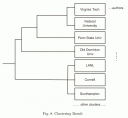Co-Authorship Networks in the Digital Library Research Community presents an investigation on the DL research community based on examination of the co-authorship network of 1567 authors, based upon papers submitted to three DL conferences from 1995 to 2003.
The research team experimented with a number of metrics intended to characterize the network, which are detailed in the paper. The group concluded that the co-authorship network demonstrated a relatively high degree of clustering with smaller components; that is, it seems apparent that the DL research community is significantly more disperse than other research communities.
This would seem to indicate that the research community might contain several structural holes. The figure below represents a clustering applied to authors within the network, using a distance metric based on inter-authorship similarity. The smallest clusters formed within the institutions shown at the first level of the clustering. Based on what we discussed in class, one would then expect the authors connecting clusters to be, in a sense, more powerful.
This is indeed the case. Consider the following example: the authors from LANL, Cornell, and Southampton form a first level cluster. Carl Lagoze, a researcher here at Cornell, has been at the forefront of collaborative projects with each institution (the Open Archives Initiative with LANL and the Open Citation Project with Southampton). Furthermore, Lagoze is ranked very highly by several of the group’s measures of author importance. It seems reasonable to attribute this status due to his position within the co-authorship network.



* You can follow any responses to this entry through the RSS 2.0 feed.